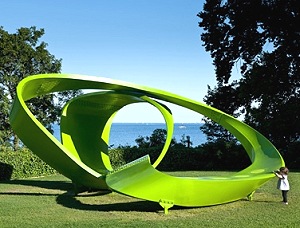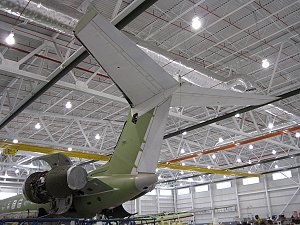COMPOSITES
Winners of the JEC Innovation Awards 2010 / Focus on bio-based materials, aeronautics, transportation and sports / 11 companies awarded
This year, the judges at JEC’s (Paris / France; www.jeccomposites.com) Innovation Awards truly were spoilt for choice. With applications from 22 different countries throughout the world, making a decision on which company will receive what award surely was not easy. Now in its twelfth year, this year JEC will be awarding companies that have developed innovations in the following fields: environment and recycling, bio-based materials, aeronautics, building and construction, sports and leisure, transportation, wind energy, raw materials, as well as process and automation.
The awards will be handed out at the JEC Composites Show, held 13-15 April 2010.
The awards will be handed out at the JEC Composites Show, held 13-15 April 2010.
And the winner is….
 The bio-based exhibit by 3NX architects was displayed at the UN´s Climate Conference in Copenhagen (Photo: JEC) |
3XN architects (Copenhagen / Denmark, www.3xn.dk) came in first in the environment and recycling category. Using only bio-based materials, the Danish designers built an energy-self-sufficient exhibit, which undergoes a biological process of decomposition after use. The structure is made of flax fibres, soybean oil, cornstarch and sheets of cork and its gelcoat is covered by a nanoproduct that breaks down pollution particles using sunlight and also has self-cleaning properties. The structure is currently on display at the Louisiana Museum of Modern Art near Copenhagen.
In the bio-based materials category, Lineo’s (Bernay / France; www.lineo.eu) flax-based commercial prepreg and its yarn treatment and impregnation process convinced the judges. Overcomes existing technological barriers associated with flax, this new process allows flax fibres to be prepared and impregnated with epoxy resin, illustrating that it is possible to incorporate renewable materials into composite parts without having to compromise on mechanical properties.
In the bio-based materials category, Lineo’s (Bernay / France; www.lineo.eu) flax-based commercial prepreg and its yarn treatment and impregnation process convinced the judges. Overcomes existing technological barriers associated with flax, this new process allows flax fibres to be prepared and impregnated with epoxy resin, illustrating that it is possible to incorporate renewable materials into composite parts without having to compromise on mechanical properties.
 Fokker Aeronautic's induction-welded primary structure aircraft control surface is literally taking off (Photo: Fokker Aeronautics) |
Speeding past the competition in the aeronautics category was Fokker Aerostructures’ (Papendrecht / The Netherlands; www.fokkeraerostructures.com) induction-welded carbon / PPS thermoplastic composite-based primary structure aircraft control surface. The lightweight part, made of a post-buckled multi rib composite structure with think skins and a tough carbon / PPS material, was first integrated into a Gulfstream G650 business jet tail in summer last year.
Spurred by the desire to prevent humanitarian catastrophes the likes of January’s earthquake in Haiti, D’Appolonia S.p.A. (Genoa / Italy; www.dappolonia.it) developed a “seismic wallpaper” to reinforce, strengthen, monitor and manage any structures likely to suffer damage during earthquakes. This solution, which increases both structural strength and ductility by more than 200%, ranked first for JEC’s innovation award for building and construction. As part of the process, the Italian group adapted textile machines to allow warp-knitting of fibre-optic cables into multilaxial fabrics, which were then coated to ensure durability and to enhance the textile-mortar interface. What’s more, the composite also includes embedded sensors that allow engineers to measure seismic events, using the data to update and manage the structure if necessary.
In the sports and leisure category, this year’s JEC innovation award goes to Corima S.A.(Loriol / France; www.corima.com) for its 100% carbon wheel. Made of UD and taffetas carbon prepreg fibres, the wheel’s rim is wrapped on a Rohacell foam. Prepreg carbon fibres are also found in hub and spokes. This high usage of carbon fibre translates into extremely low weight, an accurate weight distribution, high stiffness and good aerodynamics.
South African company Lomold (Capetown; www.lomold.co.za) received the award in the transportation category for developing a new long fibre thermoplastic (LFT) manufacturing process. Using a large and complex 3D product, the company is able to produce very long fibres (20-50mm), which in turn guarantee high mechanical properties and allow for strong, thin-walled lightweight designs. Lomold currently is building two manufacturing facilities for the pallet, in China and South Africa, with plans to add additional plants in Australia, the US and Europe.
One could say that La Tôlerie Plastique’s (Octeville sur mer / France; www.ltp.fr) new wind turbine blew the JEC judges away. Made of flax fabrics in a PLA matrix, this 100% biodegradable turbine is capable of feeding a public lighting system. Allowing energy to be produced at restricted volumes and dimensions, the turbine is suitable for a range of end users.
This year’s raw materials innovation price went to Chinese company Advanced Fiber Materials Technologies for its Han-3D-Fabrics. By sandwiching fibre sheets between Velcro (hook-and-loop fasteners), the company is able to produce 3D composites with increased interlaminate strength (50-100%). The new materials also increase compression strength by more than 20%, impact strength by about 20% and lay-up efficiency by 40%. These hook-and-loop fabrics can be made of any fibres, the company says, and they do not disturb 2D laying processes.
Belgian aerospace company Société Anonyme Belge de Constructions Aéronautiques (S.A.B.C.A., Brussels; www.sabca.com) took the award in the process category for its “modular joints for composite aircraft components” (MOJO) demonstrator. MOJO is designed for assembly by structural adhesive bonding, which offers up to 25% cost savings and a 50% reduction in weight compared to “black metal” concepts.
JEC’s judges were torn about the automation award, which in the end went to two innovations. The first is Magestic System’s (Westwood, New Jersey / USA; www.magestic.com) CLC process to test and correct the thickness of cured composite wing skins, specifically for the F-35 Joint Strike Fighter. The process can be used in wind turbine blades, yachts and automobiles as well. Using a method that compares the “as built” data with the “as designed” data, the new process allows for composite parts to be produced correctly the first time, minimising waste and maximising accuracy.
Magestic shares this top honour with EADS Deutschland (Munich / Germany; www.eads.com), which JEC chose because of its newly invented process for producing high-quality, low cost composite frames with high design flexibility and repeatability. The machine is capable of producing 30-40 aircraft a month. Designed especially for manufacturing Airbus frames, the line also is capable of producing frames with alternating cross sections and curvatures.
Spurred by the desire to prevent humanitarian catastrophes the likes of January’s earthquake in Haiti, D’Appolonia S.p.A. (Genoa / Italy; www.dappolonia.it) developed a “seismic wallpaper” to reinforce, strengthen, monitor and manage any structures likely to suffer damage during earthquakes. This solution, which increases both structural strength and ductility by more than 200%, ranked first for JEC’s innovation award for building and construction. As part of the process, the Italian group adapted textile machines to allow warp-knitting of fibre-optic cables into multilaxial fabrics, which were then coated to ensure durability and to enhance the textile-mortar interface. What’s more, the composite also includes embedded sensors that allow engineers to measure seismic events, using the data to update and manage the structure if necessary.
In the sports and leisure category, this year’s JEC innovation award goes to Corima S.A.(Loriol / France; www.corima.com) for its 100% carbon wheel. Made of UD and taffetas carbon prepreg fibres, the wheel’s rim is wrapped on a Rohacell foam. Prepreg carbon fibres are also found in hub and spokes. This high usage of carbon fibre translates into extremely low weight, an accurate weight distribution, high stiffness and good aerodynamics.
South African company Lomold (Capetown; www.lomold.co.za) received the award in the transportation category for developing a new long fibre thermoplastic (LFT) manufacturing process. Using a large and complex 3D product, the company is able to produce very long fibres (20-50mm), which in turn guarantee high mechanical properties and allow for strong, thin-walled lightweight designs. Lomold currently is building two manufacturing facilities for the pallet, in China and South Africa, with plans to add additional plants in Australia, the US and Europe.
One could say that La Tôlerie Plastique’s (Octeville sur mer / France; www.ltp.fr) new wind turbine blew the JEC judges away. Made of flax fabrics in a PLA matrix, this 100% biodegradable turbine is capable of feeding a public lighting system. Allowing energy to be produced at restricted volumes and dimensions, the turbine is suitable for a range of end users.
This year’s raw materials innovation price went to Chinese company Advanced Fiber Materials Technologies for its Han-3D-Fabrics. By sandwiching fibre sheets between Velcro (hook-and-loop fasteners), the company is able to produce 3D composites with increased interlaminate strength (50-100%). The new materials also increase compression strength by more than 20%, impact strength by about 20% and lay-up efficiency by 40%. These hook-and-loop fabrics can be made of any fibres, the company says, and they do not disturb 2D laying processes.
Belgian aerospace company Société Anonyme Belge de Constructions Aéronautiques (S.A.B.C.A., Brussels; www.sabca.com) took the award in the process category for its “modular joints for composite aircraft components” (MOJO) demonstrator. MOJO is designed for assembly by structural adhesive bonding, which offers up to 25% cost savings and a 50% reduction in weight compared to “black metal” concepts.
JEC’s judges were torn about the automation award, which in the end went to two innovations. The first is Magestic System’s (Westwood, New Jersey / USA; www.magestic.com) CLC process to test and correct the thickness of cured composite wing skins, specifically for the F-35 Joint Strike Fighter. The process can be used in wind turbine blades, yachts and automobiles as well. Using a method that compares the “as built” data with the “as designed” data, the new process allows for composite parts to be produced correctly the first time, minimising waste and maximising accuracy.
Magestic shares this top honour with EADS Deutschland (Munich / Germany; www.eads.com), which JEC chose because of its newly invented process for producing high-quality, low cost composite frames with high design flexibility and repeatability. The machine is capable of producing 30-40 aircraft a month. Designed especially for manufacturing Airbus frames, the line also is capable of producing frames with alternating cross sections and curvatures.
18.02.2010 Plasteurope.com [215532]
Published on 18.02.2010

 German version of this article...
German version of this article...